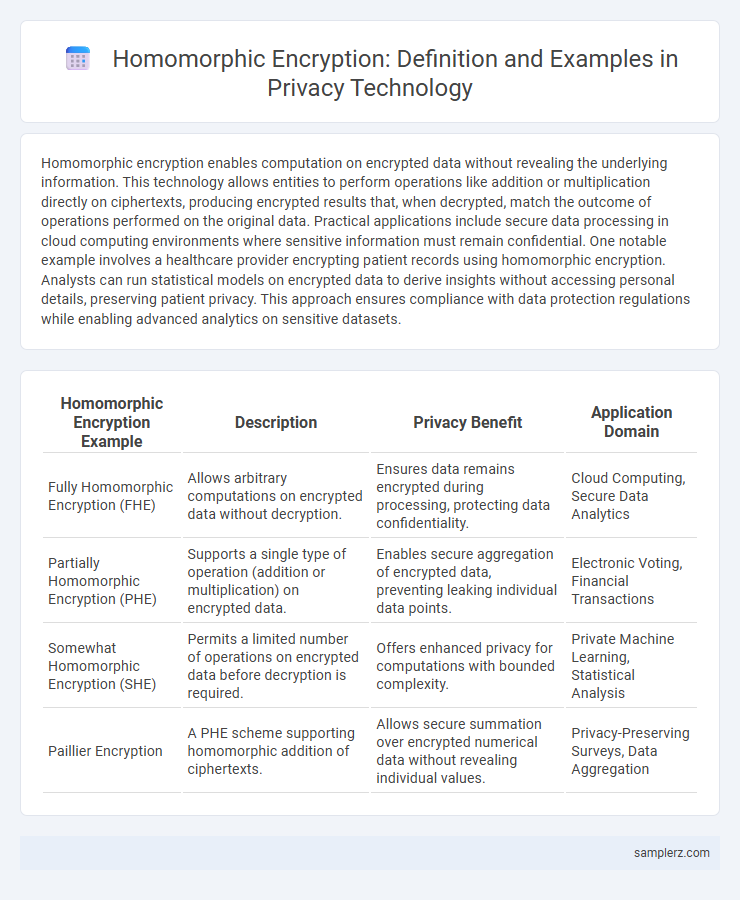Homomorphic encryption enables computation on encrypted data without revealing the underlying information. This technology allows entities to perform operations like addition or multiplication directly on ciphertexts, producing encrypted results that, when decrypted, match the outcome of operations performed on the original data. Practical applications include secure data processing in cloud computing environments where sensitive information must remain confidential. One notable example involves a healthcare provider encrypting patient records using homomorphic encryption. Analysts can run statistical models on encrypted data to derive insights without accessing personal details, preserving patient privacy. This approach ensures compliance with data protection regulations while enabling advanced analytics on sensitive datasets.
Table of Comparison
| Homomorphic Encryption Example | Description | Privacy Benefit | Application Domain |
|---|---|---|---|
| Fully Homomorphic Encryption (FHE) | Allows arbitrary computations on encrypted data without decryption. | Ensures data remains encrypted during processing, protecting data confidentiality. | Cloud Computing, Secure Data Analytics |
| Partially Homomorphic Encryption (PHE) | Supports a single type of operation (addition or multiplication) on encrypted data. | Enables secure aggregation of encrypted data, preventing leaking individual data points. | Electronic Voting, Financial Transactions |
| Somewhat Homomorphic Encryption (SHE) | Permits a limited number of operations on encrypted data before decryption is required. | Offers enhanced privacy for computations with bounded complexity. | Private Machine Learning, Statistical Analysis |
| Paillier Encryption | A PHE scheme supporting homomorphic addition of ciphertexts. | Allows secure summation over encrypted numerical data without revealing individual values. | Privacy-Preserving Surveys, Data Aggregation |
Real-World Applications of Homomorphic Encryption in Privacy
Homomorphic encryption enables secure data processing without exposing sensitive information, making it ideal for cloud computing and secure voting systems. Financial institutions utilize this technology to perform encrypted data analysis, ensuring client confidentiality during fraud detection. Healthcare providers apply homomorphic encryption to analyze patient data remotely while maintaining strict privacy compliance and preventing unauthorized access.
How Homomorphic Encryption Secures Cloud Data Processing
Homomorphic encryption enables secure cloud data processing by allowing computations on encrypted data without decrypting it, preserving user privacy throughout. This technology ensures that sensitive information remains confidential while leveraging cloud resources for complex data analysis or machine learning tasks. Companies like Microsoft and IBM demonstrate homomorphic encryption's capability to protect medical records and financial data in cloud environments.
Enabling Private Machine Learning with Homomorphic Encryption
Homomorphic encryption enables private machine learning by allowing algorithms to process encrypted data without decrypting it, preserving data confidentiality throughout computation. This technology is critical in sensitive fields such as healthcare and finance where user privacy must be maintained while leveraging machine learning models. By ensuring data remains encrypted during training and inference, homomorphic encryption reduces risks of data breaches and enhances regulatory compliance.
Homomorphic Encryption in Secure Electronic Voting Systems
Homomorphic encryption enables secure electronic voting systems by allowing votes to be encrypted and tallied without decryption, preserving voter privacy and preventing election fraud. This technology ensures that individual ballots remain confidential while enabling accurate vote aggregation and verification. Implementations like Microsoft SEAL and IBM HELib demonstrate how homomorphic encryption enhances the integrity and trustworthiness of digital elections.
Protecting Medical Records: Homomorphic Encryption in Healthcare
Homomorphic encryption enables healthcare providers to perform computations on encrypted medical records without exposing sensitive patient information, ensuring robust data privacy. This technology allows secure sharing and analysis of medical data for research and diagnostics while maintaining compliance with HIPAA and GDPR regulations. By processing encrypted data directly, homomorphic encryption significantly reduces the risk of data breaches and unauthorized access in healthcare systems.
Financial Privacy: Homomorphic Encryption in Banking Transactions
Homomorphic encryption enables secure processing of encrypted banking transactions without exposing sensitive financial data, preserving user privacy throughout. Banks leverage this technology to perform calculations on encrypted account balances, enabling fraud detection and risk assessment without decrypting customer information. This approach enhances financial privacy by minimizing data exposure during critical operations in digital banking systems.
Privacy-Preserving Data Analytics Using Homomorphic Encryption
Homomorphic encryption enables privacy-preserving data analytics by allowing computations on encrypted data without revealing sensitive information, ensuring data confidentiality throughout the process. Financial institutions leverage this technology to perform risk assessments on encrypted customer data, maintaining privacy while extracting valuable insights. This approach enhances regulatory compliance and safeguards user privacy in sectors handling sensitive information.
Homomorphic Encryption for Secure Data Sharing in Research
Homomorphic encryption enables researchers to perform computations on encrypted datasets without revealing sensitive information, ensuring data privacy during collaborative studies. This technology allows secure data sharing across institutions, facilitating joint analysis on genomic, medical, or financial data while maintaining confidentiality. Implementing homomorphic encryption in research environments significantly reduces the risk of data breaches and enhances compliance with privacy regulations like GDPR and HIPAA.
Privacy in Smart Grids: Role of Homomorphic Encryption
Homomorphic encryption enables secure data aggregation in smart grids by allowing computations on encrypted consumption data without decryption, preserving user privacy. This cryptographic approach protects sensitive energy usage patterns from unauthorized access while supporting real-time grid management and demand response optimization. By ensuring confidentiality during data processing, homomorphic encryption strengthens the trust and resilience of smart grid infrastructure.
Homomorphic Encryption and Private Location-Based Services
Homomorphic encryption enables private location-based services by allowing data to be encrypted while still permitting computations on it, preserving user privacy. This technology ensures that sensitive location information remains confidential during processing, preventing exposure to service providers. Companies like Microsoft and IBM utilize homomorphic encryption to enhance privacy in applications such as real-time location tracking and personalized navigation without compromising data security.

example of homomorphic encryption in privacy Infographic
 samplerz.com
samplerz.com